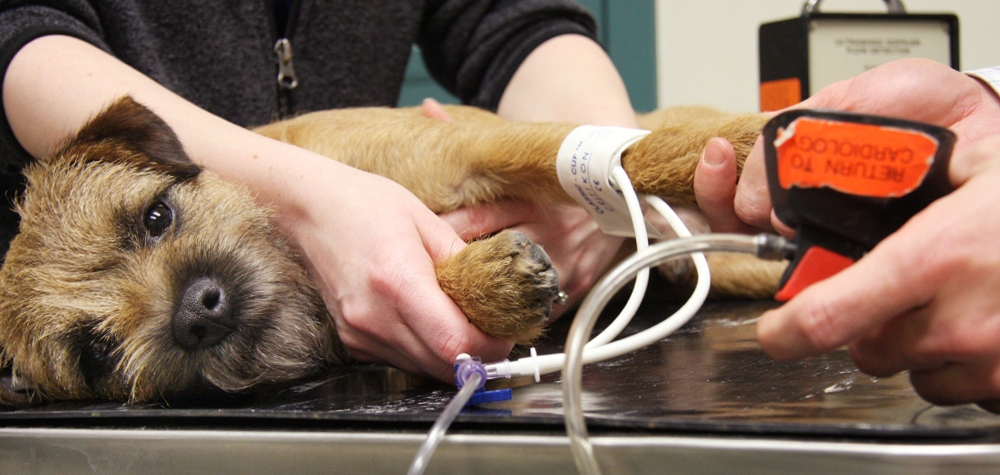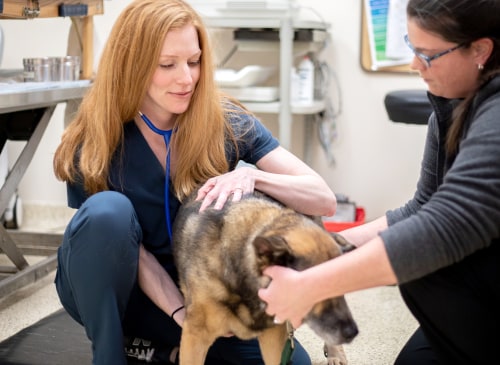What You Required to Find Out About Vet Solutions: A Review of Diagnostic Devices and Procedures
Veterinary solutions play an essential duty in preserving the wellness of pets. Normal exams can expose hidden wellness problems at an early stage. Various analysis devices and treatments, such as blood tests and imaging strategies, give crucial understandings into an animal's wellness. Recognizing these techniques is essential for pet dog owners. What details diagnostic treatments are most commonly utilized, and exactly how can they impact an animal's therapy strategy?
Importance of Normal Vet Check-Ups
While numerous animal proprietors might ignore the relevance of routine veterinary examinations, these visits are essential for keeping a pet's overall health. Routine visits to the veterinarian enable very early discovery of potential health and wellness concerns prior to they escalate into significant troubles. Regular examinations commonly consist of inoculations, which are very important for preventing contagious illness that might drastically influence a pet's wellness. Additionally, these consultations provide an opportunity for veterinarians to assess the pet's weight, dental health, and overall condition, making certain that the pet is growing. Throughout these visits, pet dog proprietors can additionally get useful advice on diet regimen, workout, and preventative treatment customized to their specific pet's needs.
Common Analysis Procedures in Vet Medicine
In vet medication, exact diagnosis is necessary for effective therapy. Usual analysis procedures include blood screening methods, advanced imaging modern technologies, and urinalysis, each playing a considerable function in determining health concerns. Understanding these methods boosts the capability to provide ideal look after pet individuals.
Blood Checking Techniques
Blood testing techniques act as necessary diagnostic tools in vet medication, making it possible for veterinarians to assess the wellness of animals accurately. These strategies include accumulating blood samples to analyze numerous components, such as white and red blood cells, platelets, and biochemical markers. Typical tests consist of complete blood counts (CBC), which review general health and identify infections, and biochemical panels, which evaluate body organ function and metabolic standing. Additionally, serological examinations can recognize particular conditions through antibody discovery. Blood screening is minimally invasive and offers crucial info that aids in identifying conditions, keeping track of health and wellness standing, and assessing actions to treatments. On the whole, these techniques play a crucial duty in guaranteeing ideal care for family pets and animals alike.
Imaging Technologies Used
Diagnostic imaging innovations are vital tools in vet medicine, enhancing blood screening techniques by supplying visual understandings right into an animal's interior frameworks. Common imaging modalities consist of X-rays, which serve for evaluating bone fractures and discovering international items, and ultrasound, which allows for real-time visualization of soft tissues and organs. Magnetic vibration imaging (MRI) uses in-depth photos of intricate physiological locations, particularly in neurological evaluations. Computed tomography (CT) offers cross-sectional pictures, improving diagnostic accuracy for various problems. Each of these innovations aids vets in identifying diseases, preparing treatments, and keeping track of recovery. By incorporating imaging innovations, veterinary professionals can much better analyze a pet's health and make notified decisions concerning their treatment.
Urinalysis and Diagnostics
Urinalysis acts as an important diagnostic tool in vet medication, offering valuable understandings into a pet's total health and wellness and aiding in the discovery of various conditions. This non-invasive procedure assesses pee samples to examine kidney function, hydration status, and metabolic conditions. Common elements checked out consist of specific gravity, pH levels, glucose, healthy proteins, and the presence of blood or germs. Uncommon searchings for can indicate problems such as urinary tract infections, diabetes mellitus, or kidney condition. To improve analysis accuracy, urinalysis is often performed combined with various other tests, such as blood job and imaging research studies. Early detection via urinalysis can lead to prompt treatments, boosting the prognosis for lots of veterinary patients. Consequently, it is an essential element of extensive vet treatment.
Comprehending Blood Examinations and Laboratory Analysis
Understanding blood tests and research laboratory analysis is crucial in veterinary medicine as it assists in identifying different health conditions in animals. Various sorts of blood examinations supply essential information regarding an animal's inner state, while analyzing lab results calls for mindful factor to consider of many factors. This area will discover the kinds of blood examinations offered and the significance of their outcomes.
Types of Blood Examinations
Blood tests play a vital role in vet medicine, offering necessary insights into a pet's health and wellness condition. Various kinds of blood tests are made use of, each serving different purposes. Complete blood counts (CBC) evaluate general wellness and identify conditions such as anemia or infection. Biochemical profiles examine organ feature by determining enzymes and electrolytes, supplying insights into metabolic wellness. Serological tests determine pop over to these guys particular antibodies or virus, assisting in the medical diagnosis of infections or autoimmune diseases. Blood inputting assurances safe transfusions, while coagulation examinations determine the blood's ability to embolisms, vital for surgeries. These tests collectively enhance medical diagnosis, treatment preparation, and tracking of a pet's wellness, highlighting the significance of complete laboratory evaluation in veterinary treatment.

Translating Laboratory Results
A complete evaluation of laboratory outcomes is necessary for exact medical diagnosis and therapy in veterinary medicine. Interpreting laboratory results calls for an understanding of regular referral varieties and the value of discrepancies. Blood examinations can disclose various wellness indicators, such as body organ function, electrolyte balance, and the existence of infections. Veterinarians must take into consideration the entire professional picture, including the pet's history, health examination searchings for, and any type of signs presented. Variations in results might arise from variables such as age, type, and underlying health and wellness conditions. As a result, lab results ought to not be viewed alone but rather as part of an all-encompassing analysis method. Exact analysis permits customized treatment strategies and far better outcomes for vet clients.
Imaging Techniques: X-rays, Ultrasounds, and Beyond
Imaging methods are important devices in veterinary medicine, supplying critical insights right into the wellness and health of animals. Amongst the most generally used techniques are Ultrasounds and x-rays. X-rays are indispensable for visualizing bone structures, assisting vets recognize fractures, growths, or foreign items. This technique is non-invasive and quick, making it optimal for immediate situations.Ultrasounds, on the other hand, use acoustic waves to produce photos of soft cells and body organs. This strategy is especially useful for examining the heart, abdomen, and reproductive organs, permitting veterinarians to evaluate conditions like fluid accumulation or organ abnormalities.Beyond X-rays and ultrasounds, advanced imaging techniques such as computed tomography (CT) and magnetic vibration imaging (MRI) are increasingly utilized in vet technique. These approaches use detailed cross-sectional pictures, improving the precision of medical diagnoses and therapy strategies. CT Scans For Animals. Generally, imaging techniques play a vital duty in making sure reliable vet care
The Role of Biopsies in Diagnosing Pet Wellness Issues
Precision in diagnosing health issues in pets frequently hinges on using biopsies, which provide clear-cut details about cells problems. A biopsy entails the removal of a tiny sample of tissue for evaluation under a microscope, allowing vets to determine various problems, including visit their website infections, growths, and inflammatory conditions. This diagnostic device is important for distinguishing between malignant and benign developments, directing therapy decisions, and evaluating the severity of a condition.Biopsies can be executed using numerous techniques, such as needle goal, incisional biopsies, or excisional biopsies, relying on the area and sort of tissue included. The choice of technique might influence recuperation time and the amount of tissue accumulated. Inevitably, the details gleaned from a biopsy can bring about targeted therapies, enhancing outcomes for animals encountering serious wellness difficulties. Vets highlight the relevance of this procedure in attaining exact medical diagnoses and effective therapy strategies.
Advanced Diagnostic Tools: Endoscopy and CT Scans

Advanced analysis devices, such as endoscopy and CT scans, play a crucial duty in contemporary veterinary medication, providing non-invasive techniques to visualize interior structures and diagnose numerous conditions in animals. Endoscopy involves the usage of an adaptable tube equipped with a camera, permitting vets to analyze the gastrointestinal tract and breathing system directly. This strategy can expose irregularities such as tumors, international bodies, or inflammation, making it possible for targeted therapy plans.CT scans, on the other hand, utilize advanced imaging modern technology to produce detailed cross-sectional pictures of the body (CT Scans For Dogs). This method is especially beneficial for reviewing complex frameworks like the brain, spinal column, and joints. By offering high-resolution photos, CT scans assist vets in determining concerns that may not be noticeable with traditional radiography. With each other, these sophisticated devices enhance analysis accuracy, enhance therapy outcomes, and inevitably contribute to far better overall pet wellness monitoring

Translating Test Outcomes: What Animal Owners Ought To Know
Understanding examination results can be a tough task for animal proprietors, particularly after innovative procedures like endoscopy and CT scans have been performed. Translating these outcomes needs a grasp of medical terminology and a clear understanding of what the searchings for suggest concerning the pet dog's health and wellness. Vets commonly provide descriptions, however the intricacy of the results can still lead to confusion.Pet proprietors need to actively take part in conversations with their veterinarians, asking concerns to clarify any kind of uncertainties. It is vital to recognize typical versus unusual outcomes and the implications for the family pet's treatment strategy. Additionally, recognizing that some results may call for more screening or monitoring can assist owners remain informed regarding their family pet's wellness trip. Eventually, a joint approach between animal owners and vet specialists fosters better health results and boosts the total treatment experience for pet dogs.
Frequently Asked Concerns
Exactly how Do I Select the Right Veterinary Center for My Family pet?
Choosing the best veterinary center includes investigating neighborhood alternatives, reviewing credentials, visiting centers, and evaluating staff interactions (Board Certified Veterinary Cardiologist). Prioritizing suggestions from trusted sources can aid assure the most effective treatment and atmosphere for a pet's wellness demands
What Should I Do if My Pet Dog Refuses to visit the Vet?
When an animal rejects to visit the vet, it's advisable to continue to be calm, usage deals with or toys to entice them, and take into consideration arranging a home see if stress and anxiety persists. Perseverance and positive support are vital.
Exist Telehealth Options for Veterinary Solutions?
Telehealth alternatives for vet services are increasingly offered, enabling animal proprietors to seek advice from with veterinarians remotely. These solutions allow discussions regarding health and wellness worries, recommendations on minor disorders, and follow-ups without requiring to check out a center.
How Often Should My Pet Have Oral Check-Ups?
The frequency of oral check-ups for pets usually depends upon their age try this out and type. Usually, veterinarians advise annual oral assessments, although some pets may call for more constant sees to maintain perfect oral health and wellness.

What Are the Costs Related To Vet Diagnostics?
The prices connected with vet diagnostics can vary widely, generally varying from basic tests like blood work to innovative imaging techniques. Elements affecting costs include the facility's area, devices used, and details tests required for each and every pet dog. Veterinary solutions play a vital function in preserving the health of animals. While many animal owners might undervalue the importance of normal vet check-ups, these visits are necessary for maintaining a pet's overall wellness. Additionally, these consultations give a chance for vets to evaluate the pet's weight, dental wellness, and general problem, ensuring that the family pet is thriving. Accuracy in diagnosing health problems in pet dogs typically hinges on the usage of biopsies, which supply conclusive details regarding tissue abnormalities. In addition, recognizing that some outcomes might require additional screening or surveillance can aid owners stay notified regarding their pet's health and wellness trip.
Comments on “How CT Scans For Animals Help Vets Detect Internal Issues Early}”